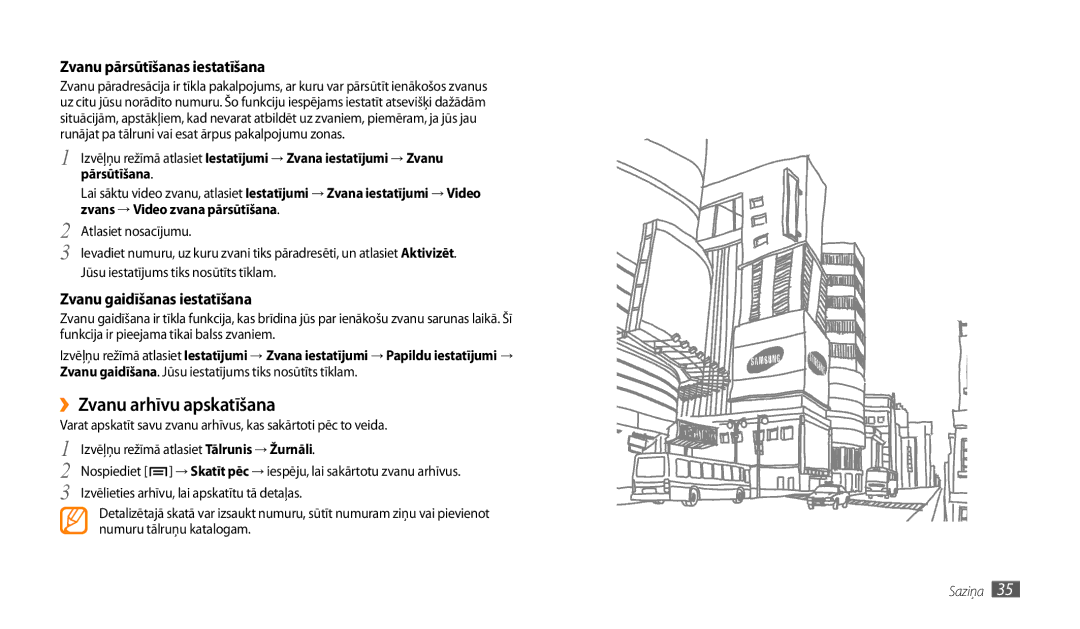Lietotāja rokasgrāmata
Rokasgrāmatas lietošana
Rokasgrāmatas lietošana
Vispirms izlasiet šo
Lūdzu, glabājiet šo pamācību turpmākai lietošanai
Izslēgšanas taustiņam
Norādījumu ikonas
Autortiesības
Prečzīmes
PAR Divx Video
Saturs
Saturs
Saziņa
Iestatījumi
Salikšana
Salikšana
Komplektācija
Akumulatora uzlāde
Atmiņas kartes ievietošana papildiespēja
SIM vai Usim kartes ievietošana
Izņemiet SD karti
››Atmiņas kartes izņemšana
››Atmiņas kartes formatēšana
››Pārslēgt klusuma režīmā
Darba sākšana
Ierīces ieslēgšana un izslēgšana
››Pārslēgt lidojuma režīmā
››Indikatora ikonas
››Taustiņi
Darba sākšana
Pareizs laiks
Skārienekrāna lietošana
››Skārienekrāna pagriešana
››Skārienekrāna bloķēšana vai atbloķēšana
››Vienumu pievienošana sākumekrānam
Iepazīšanās ar sākumekrānu
››Lietojumprogrammu kārtošana
Piekļuve lietojumprogrammām
››Vienumu pārvietošana uz sākumekrānu
››Īsceļu paneļa izmantošana
Ierīces pielāgošana
››SIM vai Usim kartes bloķēšana
››Iestatiet ekrāna bloķēšanu
Tekstu var ievadīt, atlasot rakstzīmes virtuālajā tastatūrā
Teksta ievade
››Teksta ievades metodes maiņa
››Teksta ievade ar Swype tastatūru
Ievadiet bieži izmantotos simbolus
››Teksta ievade ar Samsung tastatūru
››Teksta kopēšana un ielīmēšana
Atvērt numura sastādīšanas ekrānu
Tīmeklis
Pārlūks
››Tīmekļa lapu pārlūkošana
››Grāmatzīmju veidošana izlases tīmekļa lapām
››Informācijas meklēšana ar balsi
››Vairāku lapu atvēršana
››RSS plūsmas adreses pievienošana
Readers Hub
››Skatīt informāciju par laikapstākļiem
News and Weather
Samsung Apps
Market
››Videoklipu skatīšanās
YouTube
››Lejupielādējiet un instalējiet lietojumprogrammu
››Lietojumprogrammas atinstalēšana
Maps
Ikdienas apskats
Places
28 Tīmeklis
Navigācija
Google Search
››E-pasta ziņas skatīšana
Saziņa
Google Mail
››E-pasta ziņu sūtīšana
››E-pasta konta iestatīšana
Pasts
Ziņas
Talk
››Zvanīšana un atbildēšana uz zvanu
Zvanīšana
››Īsziņas vai multiziņas skatīšana
››Balss pasta ziņu noklausīšanās
Zvanīšana
››Izmantojiet balss zvana laikā pieejamās opcijas
Atlasiet Automātiskais noraidīto saraksts
››Iespēju izmantošana video zvana laikā
››Neatbildēto zvanu apskatīšana un atzvanīšana
››Papildfunkciju lietošana
Atlasiet nosacījumu
››Zvanu arhīvu apskatīšana
Pārsūtīšana
Zvans → Video zvana pārsūtīšana
››Mūzikas atskaņošana
Izklaide
Mūzika
››Mūzikas failu pievienošana ierīcei
››Mūzikas atskaņotāja iestatījumu pielāgošana
Music Hub
Kamera
››Atskaņošanas saraksta izveide
Kameras statusa un iestatījumu pārbaudīšana Izšķirtspēja
››Fotografēšana
→ Nepārtraukts
››Fotoattēlu sērijas uzņemšana
››Panorāmas fotoattēla uzņemšana
››Fotoattēlu uzņemšana smaidoša foto režīmā
››Videoklipa ierakstīšana
››Fotoattēlu uzņemšana pašportreta foto režīmā
››Pielāgot kameras iestatījumus
Iespējām Iespēja Funkcija Baltā balanss
››Videokameras iestatījumu pielāgošana
Pārbaudiet videkameras statusu un iestatījumus Izšķirtspēja
Nodzēst Atjaunot videokameras iestatījumus
Video
Skaņas signālu
››Videoklipa atskaņošana
Galerija
››Fotoattēla skatīšana
››Kontakta atrašana
Personiskā informācija
Kontakti
››Kontakta izveide
››Kontaktu importēšana vai eksportēšana
Kalendārs
››Kontaktu grupas izveide
››Kopēt vai pārvietot kontaktus
Piezīme
››Sinhronizēšana ar programmu Windows Media Player
Savienojamība
Savienojumi ar datoru
››Savienojums ar Samsung Kies
››Manuāla Wlan pievienošana
Wi-Fi
››WLAN funkcijas aktivizēšana
››WLAN atrašana un savienojuma izveide
Lai aktivizētu Mobile AP funkciju, atlasiet Mobile AP
Mobile AP
USB tīkla pieslēgums
››Mobilā AP funkcijas aktivizēšana
››Datu sūtīšana, izmantojot Bluetooth bezvadu funkciju
Bluetooth
››Bezvadu Bluetooth funkcijas ieslēgšana
››Bluetooth ierīču meklēšana un savienošana pārī
››Failu atskaņošana citā ierīcē ar Dlna funkciju
AllShare
››Aktivizēt atrašanās vietas pakalpojumus
Savienojumi ar TV TV izejas režīms
ThinkFree Office
Rīki
Grāmata
››Atbalstītie failu formāti
Mani faili
››Dokumenta apskatīšana un rediģēšana ierīcē
››Dokumentu pārvaldīšana tiešsaistē
Modinātājs
Fotorāmis
››Modinātāja signāla dzēšana
Uzdevumu pārvaldnieks
Pasaules pulkstenis
››Modinātāja signāla pārtraukšana
Voice Search
Bezvadu funkcija un tīkls
Iestatījumi
Piekļuve iestatījumu izvēlnei
Zvana iestatījumi
Mainiet displeja iestatījumus
Skaņas iestatījumi
Displeja iestatījumi
Atrašanās vieta un drošība
Izstrāde
Programmas
Konti un sinhronizācija
Iestatīt SIM kartes bloķēšanu
Valoda un teksts
Konfidencialitāte
SD karte un tālruņa krātuve
Meklēt
››Teksta pārveide runā iestatījumi
Balss ievade un izvade
››Samsung tastatūra
››Balss atpazīšanas iestatījumi
Par tālruni
Pieejamība
Datums un laiks
Problēmu novēršana
Problēmu novēršana
Izvēlni Bloķēt SIM karti
Pārbaudiet, vai netiek bloķēta ierīces iekšējā antena
Izejošie zvani nesavienojas
Atverot mūzikas failus, tiek parādīti kļūmes paziņojumi
Neizmantojiet ierīci citu elektronisku ierīču tuvumā
Drošības pasākumi
Sargājiet ierīci, akumulatorus un lādētājus no bojājumiem
Izslēdziet ierīci, ja tā norādīts
Izslēdziet ierīci, atrodoties lidaparātā
Neizmantojiet ierīci elektrokardiostimulatora tuvumā
Izslēdziet ierīci sprādzienbīstamā vidē
Nenometiet ierīci un nepakļaujiet to citu veidu triecieniem
Neļaujiet ierīcei samirkt
Neglabājiet ierīci uz nelīdzenas virsmas
Neglabājiet ierīci magnētisko lauku tuvumā
Nenēsājiet ierīci aizmugures kabatā vai ap vidukli
Runājot pa ierīci
Dzirdes saudzēšana
Esiet uzmanīgi, izmantojot ierīci pārvietojoties
72 Drošības pasākumi
Izstrādājuma pareiza likvidēšana
Drošības pasākumi
Indikatora ikonas
Alfabētiskais rādītājs
Atbalstītie failu formāti
Sērijas uzņemšana 39 skatīšana 43 uzņemšana
Importēšana vai eksportēšana 45 izveide
Konti un sinhronizēšana
Iespēju izmantošana 34 veikšana
ThinkFree Office Tīmekļa pārlūks
EN 62311
Saskaņā ar mūsu atbildību atzīstam, ka šis produkts
EN 50332-1
EN 50332-2
Kies sinhr. ar datoru instalēšana

